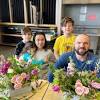Identifying the genes that viruses ‘steal’ from ocean microbes

The microbes that cycle nutrients in the ocean don’t do the work on their own – the viruses that infect them also influence the process. It’s a vital job for the rest of the planet, enabling oceans to absorb half of the human-generated carbon in the atmosphere and produce half of the oxygen we breathe.
A new study gets scientists closer to more fully understanding where viruses fit into the global ocean picture of cycling nutrients such as nitrogen, phosphorous and, of particular interest, carbon. The research broadly expands on a 20-year-old finding that genes can be exchanged between viruses and the photosynthetic cells they infect and consolidates data resulting from more than 100 papers on viruses and metabolism that followed.
The research team, led by The Ohio State University, reports in the journal Microbiome on its creation of a catalog of genes that viruses “stole” from the marine microbes they infected across all of the world’s oceans. Scientists identified and organized almost 23,000 genes known as auxiliary metabolic genes (AMGs), including over 7,000 never previously documented. The analysis suggests that about 1 in 5 ocean virus populations carries at least one AMG.

Adding even more context to the viruses’ role, the researchers mapped 340 metabolic pathways attributed to microbes in the oceans – changes to the nutrient balance resulting from organisms consuming and generating molecules based on their survival needs. Of those, the scientists found that viral AMGs mapped to 128 pathways – meaning viruses affected over 37% of those processes.
“We still don’t know the extent of viruses’ impact. But now that we know the pathways that viruses target via AMGs, we could use metabolic modeling approaches to quantitatively estimate the viral impact on the host communities and ocean functioning,” said first study author Funing Tian, who completed the work as a PhD student in microbiology at Ohio State.
“Future modeling work could involve increasing or decreasing metabolic fluxes occurring through these pathways and seeing how the impact of viruses would change.”
Tian and her co-lead author, former Ohio State microbiology postdoctoral scholar James Wainaina, focused on DNA viruses that infect prokaryotes: bacteria and other single-celled organisms floating throughout the world’s oceans.

Wainaina and Tian were members of the lab led by the study’s senior author, Matthew Sullivan, professor of microbiology and founding director of the Center of Microbiome Science at Ohio State.
Sullivan was the virus coordinator for the Tara Oceans Consortium, a three-year global study of the impact of climate change on the world’s oceans. As part of that international collaboration, he has led previous work to catalog close to 200,000 DNA and 5,500 RNA virus species in the oceans, and to ascertain viruses’ potential to mitigate climate change.
Tian and Wainaina analyzed 7.6 terabytes of Tara Oceans metagenomic sequence data for this study, increasing the known ocean DNA virus populations to 579,904. From these populations, the team took many computational steps to identify the auxiliary metabolic genes located in virus genomes.
They conservatively identified a total of 86,913 AMGs that grouped into 22,779 sequence-based gene clusters. Of those, 7,248 were identified for the first time. Viruses lift these genes from the microbial cells they infect and incorporate the genes into their own genome – giving them the power to reprogram a host cell’s function in a way that ensures viral survival.

“The challenge with auxiliary metabolic genes is that people know they’re there, but the gene is similar to the cellular copy – that makes it important to differentiate between the viral copy and the microbial copy,” Wainaina said.
“To minimize false positives, we undertook curation steps to make sure we focused only on AMGs that were on viral genome segments,” Tian said.
They then further analyzed the genomic data to determine metabolic pathways – each one a series of related actions that alter a cell’s function – that could be traced to specific microbial species, revealing 340 such pathways. With their new catalog of “stolen” genes, the researchers found that 128 of these pathways were targeted by viral AMGs.
“That’s our big finding,” Tian said. “Before this paper, it was unknown how many metabolic pathways were encoded in microbes throughout the global oceans, and even less understood among those how many were targeted by viruses via AMGs.”
Added Wainaina, “It’s not only about the number, but also which specific pathways viruses are involved in – that informs the biogeochemical cycles viruses are reprogramming and manipulating in the ocean.”
The AMG catalog and metabolic pathway mapping provide a foundation for microbiome engineering experimentation and modeling that will help researchers make more accurate predictions about viruses’ roles in ocean biogeochemical processes, Sullivan said.
“Most current models don’t include viruses at all, and only some include microbes,” he said. “It’s exciting that we’ve generated these data that are critical for bringing viruses and their impacts into new predictive models.”
This work was supported by the National Science Foundation, the Gordon and Betty Moore Foundation, the Natural Sciences and Engineering Research Council of Canada, the Canada Foundation for Innovation, the G. Unger Vetlese and Ambrose Monell Foundations, and the Ohio Supercomputer Center.
Tian is now a bioinformatician at the University of Chicago, and Wainaina is an assistant scientist in the Biology Department at Woods Hole Oceanographic Institution. Additional co-authors include Cristina Howard-Varona, Guillermo Domínguez-Huerta, Benjamin Bolduc, Garrett Smith, Marissa Gittrich, Olivier Zablocki and Dylan Cronin of Ohio State; Maria Consuelo Gazitúa of Viromica Consulting; Damien Eveillard of Nantes Université; and Steven Hallam of the University of British Columbia.


 Canada
Canada Argentina
Argentina  Australia
Australia  Austria
Austria  Brazil
Brazil  Germany
Germany  Ireland
Ireland  Italy
Italy  Malaysia
Malaysia  Mexico
Mexico  New Zealand
New Zealand  Poland
Poland  South Africa
South Africa  United Kingdom
United Kingdom  United States
United States 
























